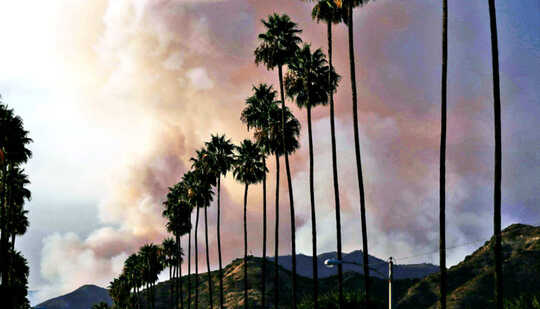
Warnings of another severe wildfire season abound, as do efforts to reduce the risk of ignition. Yet few people take precautions against wildfire smoke, experts say.
On the heels of the worst wildfire season in California history, an extended megadrought is priming the state for more destructive blazes in 2021. Given the severity of last year’s fires, many Bay Area communities are facing the imminent threat more proactively.
Efforts to mitigate the potential devastation include fuel reduction programs to remove and separate flammable vegetation; ongoing PG&E power line inspections; and the formation of neighborhood Firewise committees to encourage home-hardening, the safety measures property owners can take to make their homes more fire resistant.
But while these programs address an urgent need to reduce the risk of ignition, few are ready for the toxic air that inevitably accompanies wildfires, according to Bruce Cain, professor of political science and the director of the Bill Lane Center for the American West at Stanford University.
Get The Latest By Email
“It’s startling how ill-prepared folks are for the smoke,” Cain says. “Ideology and education affect whether or not people take this problem seriously. We know how harmful and widespread exposure to wildfire smoke is, but while people see flames as this indisputable danger, we’ve found that the smoke does not significantly impact policy preferences.”
The health effects of wildfire smoke are well-documented in research by Kari Nadeau, director of Stanford’s Sean N. Parker Center for Allergy & Asthma Research, and Mary Prunicki, the center’s director of air pollution and health research.
In a March Stanford symposium on wildfire in the West, Nadeau described the 200-plus toxins that shroud the air during a wildfire, highlighting particulate matter and soot balls as main offenders.
But any of the products one normally finds under the kitchen sink—including Drano, dishwasher fluid, cleaning supplies, and soap—also contribute to the problem, Nadeau says. “This all gets up in the air—microplastics, volatile organic compounds, heavy metals, and any kind of nitrogen oxide species.” Once released, the toxins can easily enter the lungs, presenting a whole host of health concerns.
While the hazardous air quality is certainly cause for alarm, there are precautionary measures people can take to protect their health during wildfire season.
Here, experts talk about four key problems associated with wildfire smoke, and offer some practical tips about how to stay safe:
Problem 1: Wildfire smoke is highly toxic, and particulate matter easily gets into the lungs and then the bloodstream.
The number of smoky days in California and the West due to wildfire is increasing drastically, Nadeau said during the wildfire symposium, with some parts of the region seeing an average of over 140 days per year of poor air quality. During the 2018 Camp Fire, levels of PM2.5—inhalable particles 2.5 micrometers in diameter or smaller—exceeded 200 micrograms per meters cubed. “The typical level is 9,” Nadeau says. “This is like smoking 8-10 cigarettes. These are very unhealthy levels of exposure.”
The reason wildfire smoke causes so much harm is that particulate matter can be inhaled into our lungs. From there, smaller organic compounds can make their way into our bloodstream and are circulated throughout our bodies.
“These toxins are super detrimental to health, shortening the life span and decreasing quality of life,” Prunicki says.
Health effects can include heart attacks, strokes in the elderly, allergy exacerbation, intensification of autoimmune disorders, increased risks of diabetes, stress, and post-traumatic stress disorder. Firefighters exposed to the toxins over the long term have died from lung cancer. Children and the elderly are particularly vulnerable, as are pregnant women.
Solution: One of the most important ways to protect oneself from these health hazards is to simply know the outside air quality, both at home, work, and school, says Prunicki. A number of apps and websites can be used to track the Air Quality Index (AQI), and when AQI is high, stay inside as much as possible, she advises. If it is necessary to go outside, N95 masks can be effective at keeping out particulate matter, but it is difficult to maintain a good seal on the face for an extended period of time. Cloth masks, while better than nothing, provide very limited protection, she says.
Prunicki also recommends purchasing a portable air monitor and air purifiers for inside the home, though she notes the latter can be expensive. “Change your air filters, and if you can’t purify your entire residence, set up a clean air room,” she suggests. In other words, rather than trying to filter the whole house, focus on maintaining healthy air quality in one room. Reducing the volume of air that a purifier must filter goes a long way in lowering concentrations of smoke particles.
Also, “if you or your child have asthma, make sure you’re ready to go with refills for prescriptions on inhalers,” Prunicki says. “And try to only go out when the AQI is lower.”
Problem 2: Staying inside is helpful on smoky days, but indoor air is unregulated and not always clean either. Older homes or poorly maintained homes are less likely to have windows and doors that effectively keep smoke out.
When pollution originates outdoors, air quality tends to be less hazardous indoors. “If you were to measure your AQI indoors, you’ll find that’s it’s lower than outside in your backyard or on the street where you live,” says Lynn Hildemann, professor and department chair of civil and environmental engineering.
But the degree to which your indoor air quality is better than outdoors depends on various factors, explains Hildemann, who researches indoor aerosols and human exposure to particulate matter. While everyone can close their windows on a smoky day to reduce the rate at which outdoor air enters the home, some homes are leakier than others. “Depending on the age and maintenance of your home, it may not be as well-sealed as it could be,” she says. “And if it’s leaky, you may have a fair bit of outdoor air coming in.”
Solution: Hildemann stresses the importance of knowing indoor as well as outdoor air quality. She recommends requesting a home energy audit—free in many areas—to assess how well-sealed a residence might be. The audit should identify energy-saving measures to better secure areas where smoke could otherwise slip in.
In homes with central air conditioning, the system should be run on smoky days. An air conditioner’s filter is designed to trap dust and small particles, so it offers some protection, Hildemann adds.
Problem 3: The air filters and purifiers that offer effective protection are expensive and advertising is deceptive.
For an air purifier to do its job, the unit must have a very substantial flow rate and a high-quality filter. Not all purifiers are created equal: “The inexpensive little ones you can put on your desk, if you kept your face in it all day you’d get some benefit,” Hildemann explains. “But if you’re farther away, there’s just no benefit.” Moreover, the cheaper models often overpromise and under-deliver: “A lot of these less expensive filtration units say they can move a certain amount of air through, but flow rate decreases dramatically if the filter gets full or clogged up,” she warns.
Filters with a “high-efficiency particulate air” designation (HEPA filters) provide the highest efficiency of removal, but shoppers must be wary of deceptive advertising. Hildemann recounts seeing purifiers marketed as “HEPA-like” or “approaching HEPA” quality. It is unlikely that such products would meet the actual HEPA standard of filtration.
Solution: True HEPA filtration, as defined by the US Department of Energy, should be able to remove 99.97% of airborne particles. So that’s the number to be scanning for on the box, Hildemann says.
For those without access to a high-quality filter or for those with larger homes, Hildemann echoes Prunicki’s suggestion of creating a single room in the residence where a small filter or less efficacious filter could go farther toward preserving healthy air quality.
Problem 4: When it comes to individuals’ exposure to wildfire smoke, there are inequities in protection and impact.
Economist Marshall Burke, associate professor of earth system science in the School of Earth, Energy & Environmental Sciences, has studied the toxicity of wildfire smoke from an environmental justice perspective. Leakier structures in less economically advantaged communities allow more particulate matter to travel indoors, Burke explained during a May presentation at a Stanford symposium on energy and water in the West.
Lower-income areas, and neighborhoods that are more ethnically diverse or contain more racial minorities have much higher PM2.5 levels inside. This doesn’t bode well for health outcomes in these communities, and it has prompted exploration of policies to better protect those harmed by the inequities.
Solution: This is a tough one for individuals to solve on their own. The environmental justice issues Burke is investigating point to complex societal problems. But the good news is that practical policy solutions, such as funding energy retrofitting for homes, could potentially mitigate harm to these vulnerable populations, Burke says.
For example, during his presentation at the energy and water symposium, Burke discussed President Biden’s infrastructure plan that sets aside more than $200 billion for residential energy efficiency. And energy-efficient homes are also more likely to seal out wildfire smoke.
“Outdoor PM2.5 levels have increased dramatically from wildfires, but we spend most of our time indoors,” he remarked. “People’s homes are very different in their ability to keep out pollutants.” Energy retrofitting homes reduces the infiltration of particulate matter, so such practices could begin to chip away at both the public health crisis and the climate crisis precipitated by wildfire season’s smoky skies.
Source: Stanford University
books_health,







